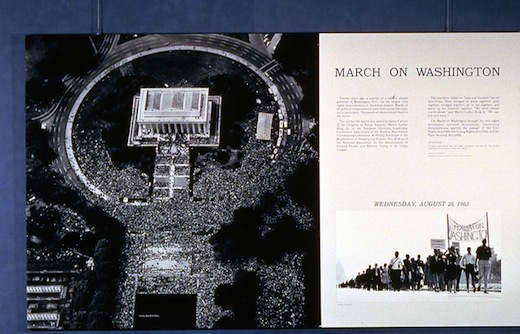
In 1963, I was a volunteer at the March on Washington‘s headquarters in Harlem. Under the leadership and direction of Bayard Rustin and his lieutenants, others and I stuffed envelopes, answered phones, provided information, and organized transport to Washington.
On the eve of the march, my task, with others, was to load people onto the fleet of buses leaving from the office and ensure that everyone who wanted to go got a seat on a bus. The last bus left close to midnight, I think, and there was no seat left for me. In the morning, I went out to La Guardia Airport and jumped on a shuttle to Washington. As the plane flew low over Washington I looked out the window and my heart sank. I couldn’t see any people on the ground. Would the promised numbers not materialize? Then I suddenly realized that what I was seeing was not the ground but the masses of people; so many people that the streets below were completely covered. I burst into tears. That memory has stayed with me for 50 years; I didn’t need the invitation to write about it to recall it.
Everyone knows about Dr. King’s magnificent speech but I feel it is important that Rustin’s role and influence has recently been recognized and written about. I’m glad too that in recent times the focus on the March on Washington has broadened to include a reminder that it was a march for jobs as well as for freedom and equal treatment. Bayard himself always acknowledged and paid tribute to others in the movement who supported the march: the trade union leaders, especially of course A. Philip Randolph, the leaders of national and local progressive churches and synagogues, the community activists from all across the United States. The march office remained open and functioning for a time after August 1963 and the phone calls and letters (well before email of course) that came in provided evidence that all those people, in organizing participation on the day, were also building activist movements and participation in the ongoing struggle for “jobs and freedom.”
A postscript: Earlier that year I and others had participated in a sit-in at the office of the governor of New York to protest work on state building projects being carried out by companies and unions who would not hire or accept as members Black workers. We were arrested for trespassing and during the week of the march we had been in court. Our lawyers, Percy Sutton and Mark Lane, asked that our trial be suspended for the day of the march so that we could go to Washington. We were astonished that the judge granted their request. In retrospect it may have had to do with Sutton’s position and influence in the Democratic Party – he had been Manhattan Borough president, and judges were elected.
Photo: March on Washington 1963 exhibit installation from the National Museum of American History, 1983-1984.












Comments